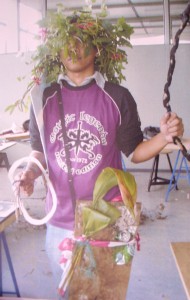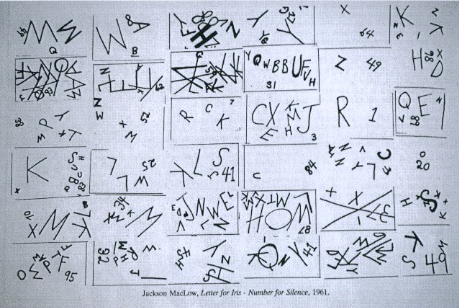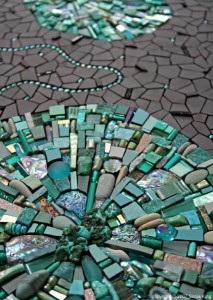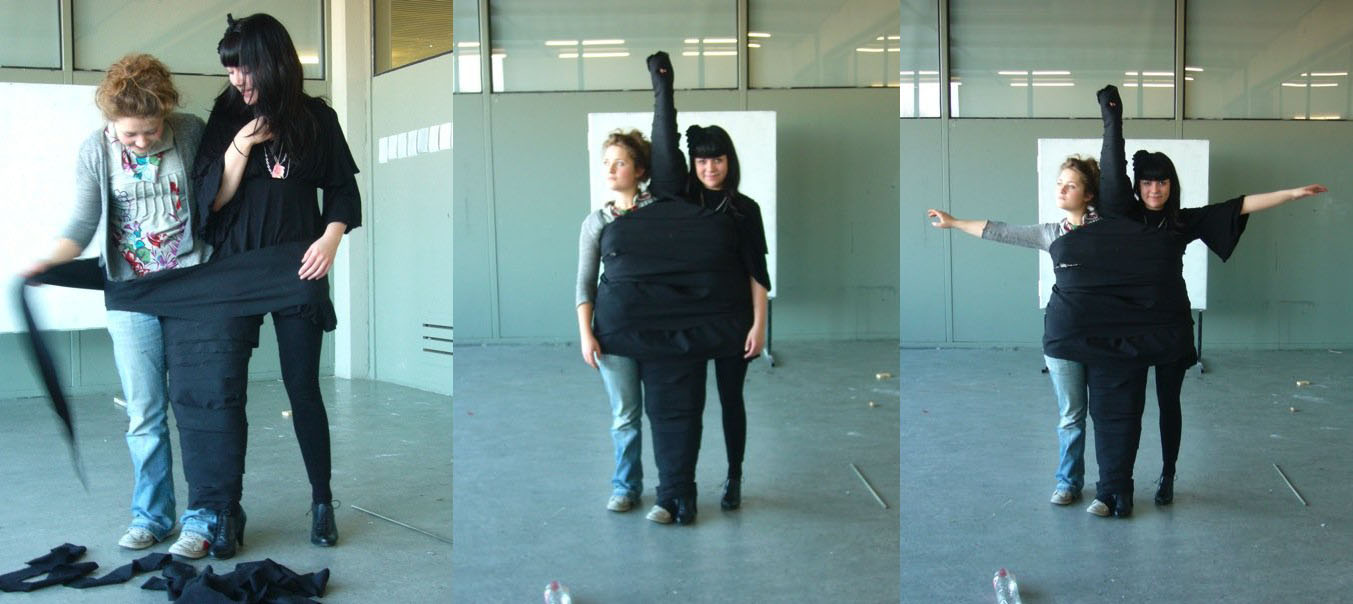Principally, I think I am relative slow… especially in doing my assignments… my brain is running the whole period… and I can’t close down… so I need typically too long to get to the point… to say “yes” to my idea… and the longer I think about it, the more difficulty it gets… from one element to the next… in the end thousand… once I felt in love with details and complicated schemes…
Then it is in the evening, one day before the deadline and I still have to work it out… working the night through… falling asleep in the middle of all the material… glue… scissor… cutter… ruler… pencils … waking up with a piece of paper glued on my nose or somewhere else…
Sometimes I love this nights… waking up and directly start to work and in between a short rest… a complete continued circle….
Never stop before perfection?
"social behavior" Category
Why take a break?
Tuesday, February 17, 2009
Weblog?
Wednesday, January 28, 2009

I was browsing the internet looking for a definition of the word ‘weblog’.
Doing so I landed up in blog after blog after blog.
Each blog having a different opinion and way of looking at the word or phenomenon blog.
I thought about this and realised that this was actually already my answer.
– The people trying to define a weblog, on a weblog. Even though they all have different opinions about it.
“There is no need to define ‘blog.’ I doubt there ever was such a call to define ‘newspaper’ or ‘television’ or ‘radio’ or ‘book’ — or, for that matter, ‘telephone’ or ‘instant messenger.’”
– Jeff Jarvis
But for the general view this might be of some help.
The Javanees
Thursday, January 22, 2009
Being a Javanees is a very greatfull feeling. That is what this “tribe” wants to do. His name is Marlon Trimo Kromojodo, but he like to call himself Trimo. Why that, because he want to hold in mind the second name of his grandfather who also is called Trimo. He got an idea to create with natural material the cloth of the “tribe”, but he does something different and creates the Javanees cloth.

This is how Trimo wants to look like. It is really a Javanees style to decorate yourself with natural material. That is the identity of being a Javenees. Like the folding leave and decorate also on the head. So Trimo create his “tribe” in a Javanees style, because it is also looks different.
Look at these: www.javanenvansuriname.info or www.picasaweb.google.com
Segregation cultivation
Thursday, January 22, 2009
Many objects are designed to be perceived as clearly male or female (think of Gilette and Venus razors for example), whereas more essential ones (kitchen appliances, electronic media, tables and beds) are made „unisex“. But when we look at the same essential objects made for children: suddenly it’s all either pink or blue!
Why this sudden change in attitude?
Why – in a world supposedly freed from gender oppression – are boys and girls being subconciously made to feel so different from one another by media and toy companies?
Is it because this makes it easier for companies to supply new products, because they don‘t have to create innovative design and can just stick to typical army- and flower-pattern? Useful as it may be to manufacturers, I doubt it‘s good for children‘s self-image and leads to much teasing in schools that could be avoided by parents paying more attention to a less stereotyped environment for their children.
Would a little girl‘s gender identity be damaged if she used a neutral or (heaven forbid) blue notebook instead of a pink one?
conjoining bodies
Thursday, January 22, 2009
Here the assignment “make a connection” became the inpiration for some reasearch on how to change two bodies into one. How to become a siamese twin. It is interesting to see the new shapes the bodies make, recognizable but totally new. This project posts questions like; what would fashion look like if the human body was formed differently and how much can fashion form our appearance. It is interesting to think about what effect clothes that conjoin two people would have on our behavior and relationships.
exchange indivisuality
Wednesday, January 21, 2009
Let’s go a bit deeper into the word indivisuality and subjects around it. Especially the subject exchange. Would you exchange your indivisuality with someone else? If you would, would you go all the way and even change your name and habits, or is it only about visual appearance? Where is the line between individuality and visuality. Can you see these two things as two different things which can be separated or are the always connected with each other? Is it possible to exchange only parts of the indivisuality or do you have to go all the way? Can you exchange your indivisuality? Or can you only pretend?
http://www.marykay.com/whatsnew/virtualmakeover/default.aspx
The Headpiece
Tuesday, January 20, 2009
I was asked to be a pedestal for Jesse Muller’s paper mohawk headpiece.
It was a delicate square helmet made from paper bags you would find at a greengrocer’s shop. It somehow reminded me of all the punk shows I used to go to when I was a teenage boy. All the loving memories I have. Beer flying though the air, people jumping over each other, off the stage, slipping on the beer stained floor, falling, bruising, laughing, the dirty squat houses, the friendly violence, the loud music, singing along. I think it’s maybe the most fun a person can ever have in his life.
posted by Tim Matijsen
Cause and Effect
Thursday, January 15, 2009
Seeking: a tool to exchange one woman‘s masculinity for one man‘s femininity (read carefully)
Most people‘s gender-conciousness & gender-identity is located in the mind, so a physical tool could only manipulate the exterior signs. Thus, the tool‘s effects are limited to the exterior, and disappear once the interaction with the tool stops. This could mean altering someone‘s posture, movement, appearance etc.
So there will be a physical difference, but one could also try to show the cause along with the effects: Where does the excess masculinity or femininity come from? Are they rooted parts of this person‘s genes or did they arise out of circumstance/necessity/coincidence during the building of their identity?
Tribe 2
Saturday, January 10, 2009
I want to introduce Nadja Voorham. She likes to dance and she wants to be a part of a tribe with no rules and religion. The biggest rule of them is “ music” and they call themself “Bling Bling”. It is a very strange tribe, because when music is playing around, they begin to dance. Very strange. They have to hear one tune and the dance automatically comes out. And when the music stops, the dance also stops. The tribe doesn’t care about the comment of the society. They are very loyal to their rule and their reputation. link to bling bling
posted by Raz Barsatie
Reviewed Printed Matter
Sunday, March 9, 2008
The International Institute of Social History (IISH) is the world’s largest documentation and research centre in the field of social history. Since its foundation in 1935, the institute has dedicated itself to the collection, preservation and availability of the heritage of social movements worldwide.
The publication “Reviewed Printed Matter” is the outcome of a review assignment which was part of the theory program Critique & Actuality in the graphic design department of the Gerrit Rietveld Academie, 2007. The eleven-day program was compiled by Kasper Andreasen and was based on studying and understanding different methodologies of reviewing and analyzing printed matter; selected posters, pamphlets, cards and books from the archives of the Institute of Social History in Amsterdam.



Nieuwe Realisten Poster 1964 - poster archive - Letter for Iris- Number of silence
The International Institute of Social History holds over 3,000 archival collections, some 1 million printed volumes and about as many audio-visual items. The available Collections are accessible through an online catalogue, an online index of archives and inventories. The IISH is also home to a number of other documentary institutions, most notably the Netherlands Economic History Archive (NEHA) and the Press Museum. Both offer supplementary collections and services. Their material is included in the IISH catalogue. Visitors can consult the collections for reference and research in the reading room.
![]()
download this research reader: Reviewed Printed Matter
[initiated by Kasper Andreasen]







